Making Vaccine
Back in December, I asked how hard it would be to make a vaccine for oneself. Several people pointed to radvac. It was a best-case scenario: an open-source vaccine design, made for self-experimenters, dead simple to make with readily-available materials, well-explained reasoning about the design, and with the name of one of the world’s more competent biologists (who I already knew of beforehand) stamped on the whitepaper. My girlfriend and I made a batch a week ago and took our first booster yesterday.
This post talks a bit about the process, a bit about our plan, and a bit about motivations. Bear in mind that we may have made mistakes—if something seems off, leave a comment.
The Process
All of the materials and equipment to make the vaccine cost us about $1000. We did not need any special licenses or anything like that. I do have a little wetlab experience from my undergrad days, but the skills required were pretty minimal.
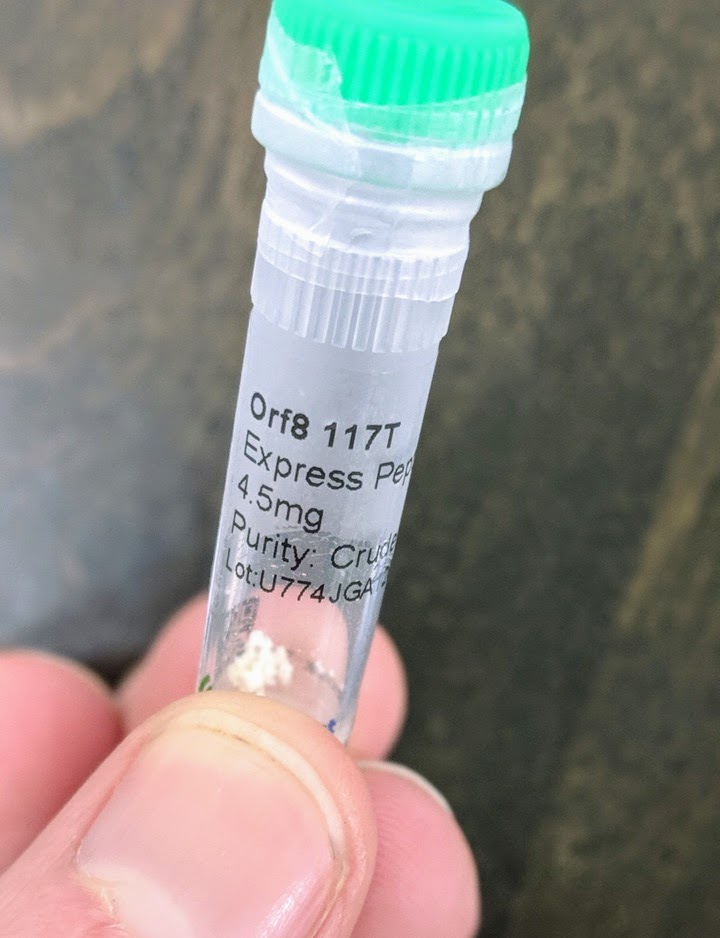
The large majority of the cost (about $850) was the peptides. These are the main active ingredients of the vaccine: short segments of proteins from the COVID virus. They’re all <25 amino acids, so far too small to have any likely function as proteins (for comparison, COVID’s spike protein has 1273 amino acids). They’re just meant to be recognized by the immune system: the immune system learns to recognize these sequences, and that’s what provides immunity.
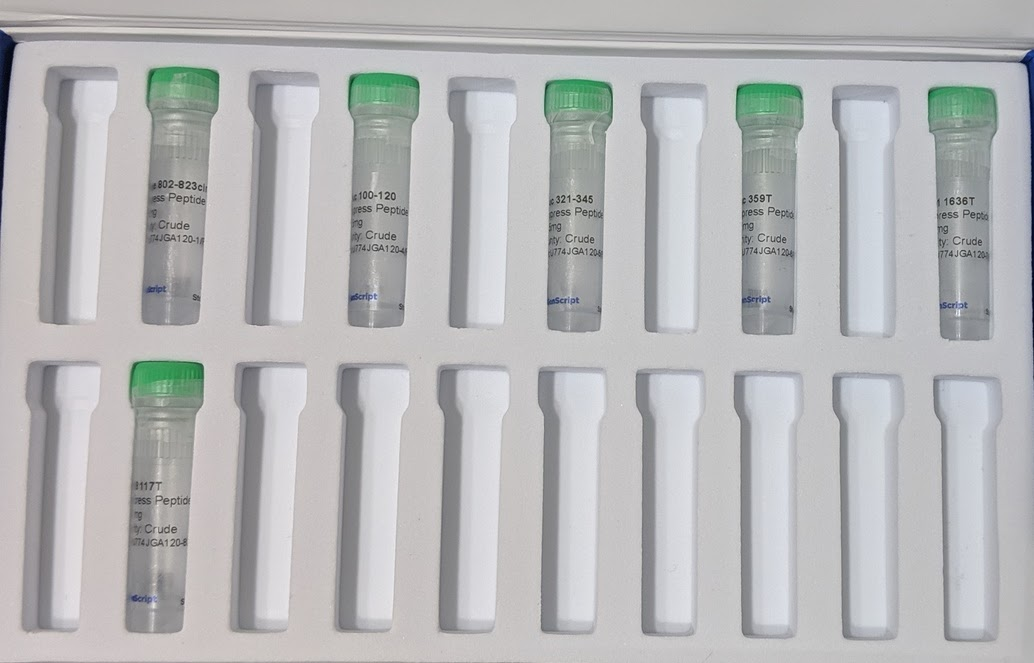
The peptides were custom synthesized. There are companies which synthesize any (short) peptide sequence you want—you can find dozens of them online. The cheapest options suffice for the vaccine—the peptides don’t need to be “purified” (this just means removing partial sequences), they don’t need any special modifications, and very small amounts suffice. The minimum order size from the company we used would have been sufficient for around 250 doses. We bought twice that much (9 mg of each peptide), because it only cost ~$50 extra to get 2x the peptides and extras are nice in case of mistakes.
The only unusual hiccup was an email about customs restrictions on COVID-related peptides. Apparently the company was not allowed to send us 9 mg in one vial, but could send us two vials of 4.5 mg each for each peptide. This didn’t require any effort on my part, other than saying “yes, two vials is fine, thankyou”. Kudos to their customer service for handling it.
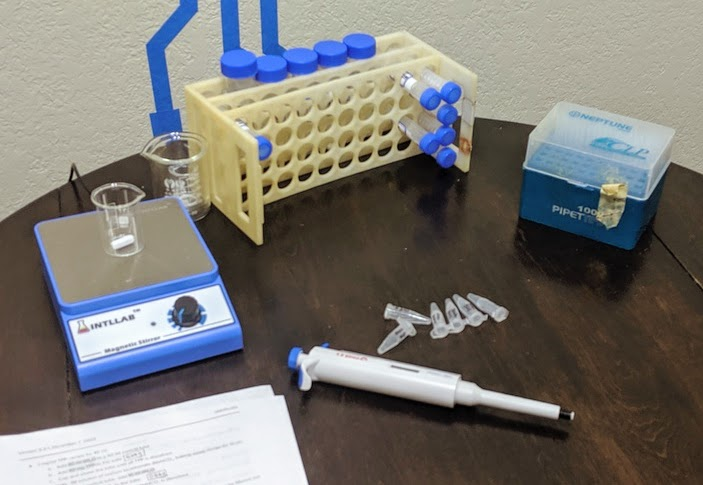
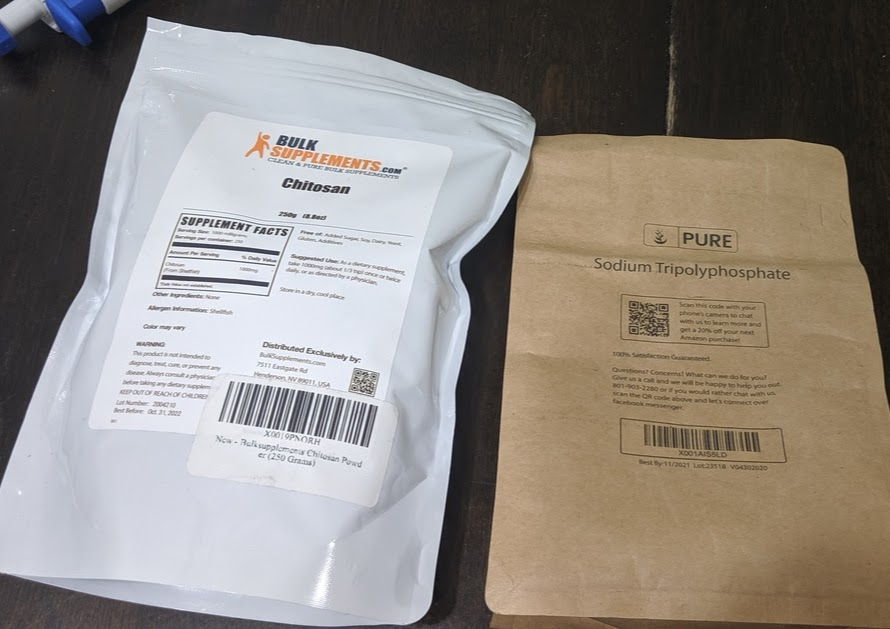
Besides the peptides, all the other materials and equipment were on amazon, food grade, in quantities far larger than we are ever likely to use. Peptide synthesis and delivery was the slowest; everything else showed up within ~3 days of ordering (it’s amazon, after all).
The actual preparation process involves three main high-level steps:
Prepare solutions of each component—basically dissolve everything separately, then stick it in the freezer until it’s needed.
Circularize two of the peptides. Concretely, this means adding a few grains of activated charcoal to the tube and gently shaking it for three hours. Then, back in the freezer.
When it’s time for a batch, take everything out of the freezer and mix it together.
Prepping a batch mostly just involves pipetting things into a beaker on a stir plate, sometimes drop-by-drop.
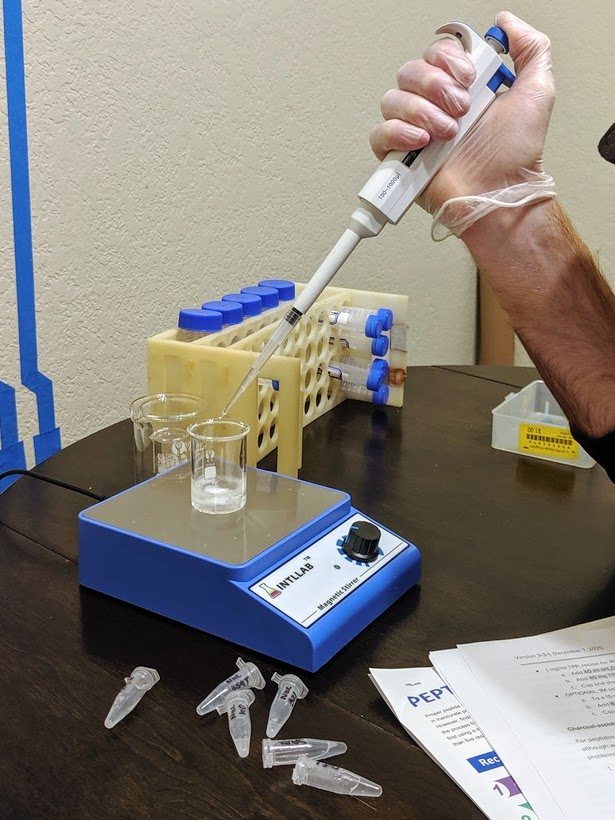
Finally, a dose goes into a microcentrifuge tube. We stick the intake tube of a sprayer into the tube, and inhale.
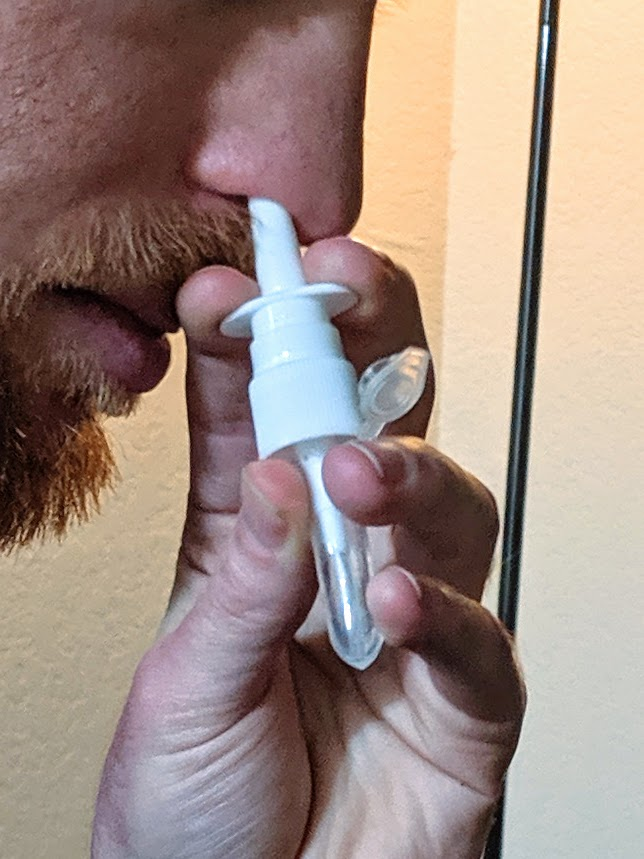
That’s the process, at a high level. Multiple boosters are strongly recommended, so there’s a few iterations of this, though only the “take stuff out of the freezer and mix it together” step needs to be repeated. See the whitepaper for the full protocol details, as well more information about each of the peptides and what the other ingredients do (summary: chitosan nanoparticles).
The Plan
The key problem is how to check that the vaccine worked. If it were injected, that would be easy: just get a standard COVID antibody test. Inhaling makes it a lot harder to hurt yourself, but also complicates testing.
The whitepaper goes into more detail and half-a-dozen different types of immune response, but the basic issue is that immunity response in the mucus lining (i.e. nose, lung, airway surfaces) can occur independently of response in the bloodstream. Commercial COVID antibody tests generally check a blood draw. In principle one can run a similar antibody test on a mucus sample, but <reasons>, so the commercial tests check blood.
(Side note: in many ways immunity in the mucus lining is better than in the blood, since it blocks infection at the point where it’s introduced. This is an advantage of inhaled vaccines over injected. So why do most commercial vaccines inject? Turns out logistics are a major constraint on commercial vaccine design, and injections are surprisingly easier logistically. One of the major relative advantages of radvac is that it’s intended to be prepared on-site shortly before administration, so it can use techniques which work better but don’t scale as well. That largely balances out the constraints of readily-available materials and simple preparation. As usual, the whitepaper goes into much more detail on this, including several other logistics-related relative advantages—multiple boosters, custom peptides, frequent design updates, etc.)
The whitepaper claims that “over a hundred” researchers have self-administered the vaccine so far, but I have not been able to find any data on test results from any of them. The paper says that inhaled vaccine can induce immunity in the blood, but I don’t have a quantitative feel for how likely that is, other than the usual assumption that more dakka makes it more likely. Meanwhile, I don’t have a convenient way to test for immune response other than the commercial tests.
So, the current plan is to search under the streetlamp. We’ll just use the commercial tests. Both of us got an antibody test before starting the project, and both came back negative.
My current model is:
If the vaccine induces an immune response in the blood, then it almost certainly induces one in the mucus lining, but the reverse does not hold. So a positive blood antibody test means it definitely works, a negative antibody test is a weak update against.
There’s some chance that a few doses are more than enough to induce a blood response.
There’s some chance that more dakka will induce a blood response, even if the first few doses aren’t enough.
So, we’ll do (up to) two more blood tests. The first will be two weeks after our third (weekly) dose; that one is the “optimistic” test, in case three doses is more-than-enough already. That one is optimistic for another reason as well: synthesis/delivery of three of the nine peptides was delayed, so our first three doses will only use six of them. If the optimistic test comes back positive, great, we’re done.
If that test comes back negative, then the next test will be the “more dakka” test. We’ll add the other three peptides, take another few weeks of boosters, maybe adjust frequency and/or dosage—we’ll consider exactly what changes to make if and when the optimistic test comes back negative. Risks are very minimal (again, see the paper), so throwing more dakka at it makes sense.
Consider this a pre-registration. I intend to share my test results here.
Motivations
Why am I doing this?
I imagine, a year or two from now, looking back and grading my COVID response. When I imagine an A+ response, it’s something like “make my own fast tests, and my own vaccine, test that they actually work, and do all that in spring 2020”. We’ve all been complaining about how “we” (i.e. society) should do these things, yet to a large extent they’re things which we can do for ourselves unilaterally. Doing it for ourselves doesn’t capture all the benefits—lots of fun stuff is still closed/cancelled—but it’s enough to go out, socialize, and generally enjoy life without worrying about COVID.
I’ve written a blog post about Benjamin Jesty, the dairy farmer who successfully immunized his wife and kids against smallpox the same year that King Louis XV of France died of the disease. I explicitly use this as an example of what Rationalism should strive to consistently achieve. Yet when a near-perfect real world equivalent came along, on super-easy mode with most of the work already done by somebody else, it still took me until December to notice. The radvac vaccine showed up in my newsfeed back in July, and I apparently failed to double-click. That level of performance is embarrassing, and I doubt that I will grade my COVID response any higher than a D.
So I’m doing this, in part, to condition the mental motions. To build the habit of Doing This Sort Of Thing, so next time I hopefully do better than a D.
Of course, the concrete benefits are nice too. But at this point it’s only ~4 months until I’d get a vaccine anyway, so the price tag is only arguably worthwhile. It’s still a fun project in its own right, and it gets dramatically cheaper with more people (remember, $1000 bought enough supplies for ~500 doses). Concretely, the largest benefits are in risk reduction. If there’s big hiccups in commercial vaccine deployment, this becomes much more worthwhile. If the South Africa strain turns out to evade commercial vaccines, this becomes much more worthwhile—the radvac design is frequently updated based on the latest COVID research, so we hopefully wouldn’t need to wait around for approval of a new commercial vaccine.
Finally, I’m curious whether it will work—or whether we’ll be able to tell that it works. It’s a data point as to just how often large bills are left sitting on sidewalks just a little ways off the beaten path.
- RadVac Commercial Antibody Test Results by (26 Feb 2021 18:04 UTC; 241 points)
- Postmortem on DIY Recombinant Covid Vaccine by (22 Jan 2022 14:12 UTC; 179 points)
- Another RadVac Testing Update by (23 Mar 2021 17:29 UTC; 138 points)
- ($1000 bounty) How effective are marginal vaccine doses against the covid delta variant? by (22 Jul 2021 1:26 UTC; 105 points)
- ($1000 bounty) How effective are marginal vaccine doses against the covid delta variant? by (22 Jul 2021 1:26 UTC; 105 points)
- Covid 2/4: Safe and Effective Vaccines Aplenty by (4 Feb 2021 14:50 UTC; 90 points)
- COVID and the holidays by (8 Dec 2021 23:13 UTC; 71 points)
- Prizes for the 2021 Review by (10 Feb 2023 19:47 UTC; 69 points)
- Voting Results for the 2021 Review by (1 Feb 2023 8:02 UTC; 66 points)
- What other peptide vaccines might it be useful to make? by (3 Mar 2021 6:25 UTC; 31 points)
- 's comment on RadVac Commercial Antibody Test Results by (27 Feb 2021 22:38 UTC; 21 points)
- 's comment on Let’s Rename Ourselves The “Metacognitive Movement” by (27 Apr 2021 16:21 UTC; 19 points)
- A platform for on-demand vaccination by (EA Forum; 18 Jul 2022 14:22 UTC; 11 points)
- Links for Feb 2021 by (1 Mar 2021 5:13 UTC; 6 points)
- 's comment on The 300-year journey to the covid vaccine by (15 Jan 2022 13:39 UTC; 4 points)
Two years later, I suppose we know more than we did when the article was written. I would like to read some postscript explaining how well this article has aged.
A great example of taking the initiative and actually trying something that looks useful, even when it would be weird or frowned upon in normal society. I would like to see a post-review, but I’m not even sure if that matters. Going ahead and trying something that seems obviously useful, but weird and no one else is doing is already hard enough. This post was inspiring.
I did eventually get covid.
As was the general pattern with this whole RADVAC episode, it’s ambiguous how much the vaccine helped. I caught covid in May 2022, about 15 months after the radvac doses, and about 13 months after my traditional vaccine (one shot J&J). In the intervening 15 months, my general mentality about covid was “I no longer need to give a shit”; I ate in restaurants multiple times per week, rode BART to and from the office daily, went to crowded places sometimes, traveled, and generally avoided wearing a mask insofar as that was socially acceptable.